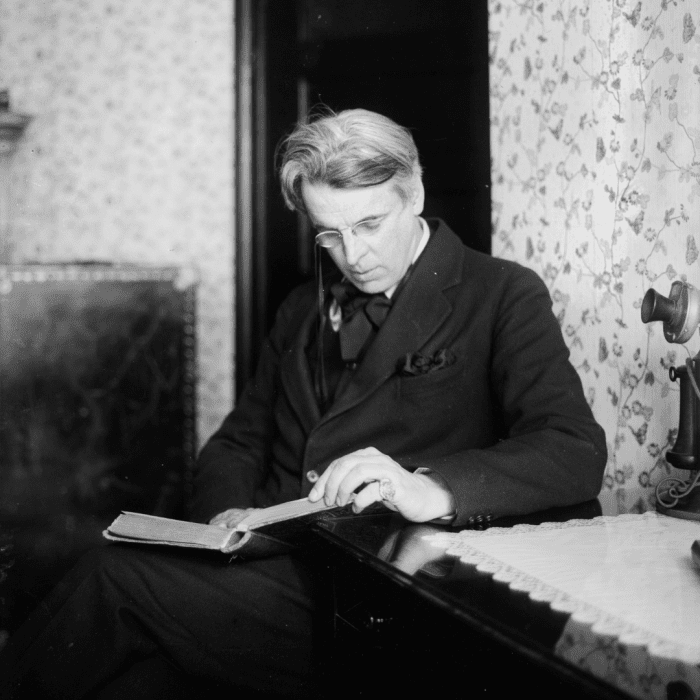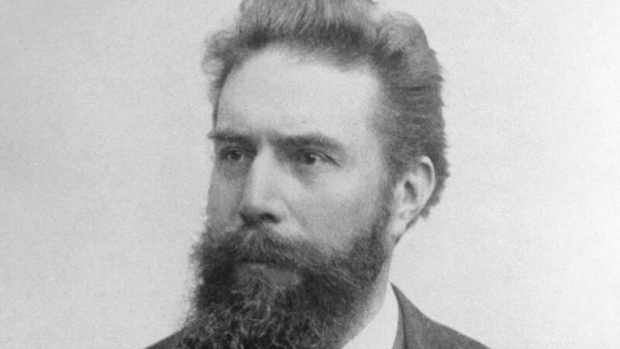W.B. Yeats's Poetry: Evocative, Reflective, and Public

Who is W.B. Yeats? Read on to learn about the Irish poet W.B. Yeats’s life and work, including three of the major themes that preoccupied him.
Who Was W.B. Yeats?
William Butler Yeats, who abbreviated his name “W.B. Yeats” as an author, was known affectionately among his friends as “Willie.” He was born on June 13, 1865, in the seaside Dublin suburb of Sandymount and died in Menton, France, on January 28, 1939. Yeats was a pillar of the Irish Literary Revival and a foremost figure in 20th-century literature. He is often characterized as being a key personality in the bridge between Romanticism and Modernism.
His style of poetry (and prose) was heavily influenced by the works of Percy Bysshe Shelley, William Blake, Stéphane Mallarmé, and William Shakespeare. He was also influenced by various Western esoteric traditions, including Rosicrucianism, Kabbalah, and Hermeticism. If his commitments to poetry and occultism speak to his mystical side, his incorporation of public events and politics in his art and his participation in public life—most notably as an Irish Senator—speak to his pragmatism and interest in the things of this world.
Due to such varied—and seemingly opposed—interests and a personality that has been described as “almost overwhelming” by his dear friend Dorothy Wellesley, Yeats is sometimes thought of as a bundle of contradictions. This is only a surface-level view, however, and a critic as great as Stephen Greenblatt has argued that a major “difficulty in reading Yeats—but also one of the great rewards—is comprehending his manysidedness.”

W.B. Yeats was highly influenced by Shelley's poem "Alastor, or The Spirit of Solitude," which was published 40 years before Yeats's birth. Yeats first read this poem with his father, John Butler Yeats, when he was an adolescent.
W.B. Yeats’s Poetry
W.B. Yeats's poetry is certainly filled with evocative language, exploring themes and ideas both personal and public. Thematically, he does not write on startlingly unusual topics—still, his manner of discussing his subject matter, and the clever way in which he explores poignant ideas, is what makes his poetry so special.
He is often intensely personal and writes with barefaced honesty, discussing such themes as death and aging, his unreserved opinions of Irish society, the sensitive twin issues of patriotism and national heroes, and his ongoing struggle to accept reality when so consumed by ideals. Symbols and images, presented alongside evocative language, aid in his expression of these themes.
In this article, we'll take a look at three major subjects Yeats returned to numerous times in his poetry:
- Death, Aging, and Immortality
- Patriotism and Nationalism
- Nature

This is the Sopwith Camel, the aircraft that Major Robert Gregory flew at the time of his death. It has been speculated that Gregory was either shot down over Italy by friendly fire or that he died in a flying accident.
1. Death, Aging, and Immortality
The combined themes of death, aging, and immortality, and Yeats’s obvious obsession with all three, dominate much of his poetry. Let’s take a look at three poems of Yeats’s that are concerned with these themes.
An Irish Airmen Foresees His Death
The simplest example, perhaps, of this topic is seen in the poem, “An Irish Airman Foresees His Death,” written following the death of his friend Augusta Gregory’s son, Major Robert Gregory, who was shot down in the First World War when fighting for the British troops.
The poem is interesting because it does not draw strong conclusions about its subject. Yeats does not make a hero of the now-dead airman, nor does he launch into a great tirade about the futility of war. Instead, he engages on a very personal level with the pilot and speculates about his reasoning and rationale: no “law, nor duty bade [him] fight, nor public men, nor cheering crowds.” Instead, some mysterious, secret thrill—“a lonely impulse of delight”—led him to where he now sat, preparing to die in a “tumult in the clouds.”
This idea of death, so light and simple, a death neither amplified nor heroised but chosen out of some sort of mystical rapture, is profound and yet, so real. Yeats demonstrates here his ability to perceive human nature aptly and presents this with evocative language: “I balanced all, brought all to mind, / The years to come seemed waste of breath, / A waste of breath the years behind / In balance with this life, this death.”
The Wild Swans at Coole
Similarly, death is also discussed in the alluring, enchanting poem “The Wild Swans at Coole.” Furthermore, his preoccupation with aging, which we likewise witness in poems such as “Sailing to Byzantium,” is at the forefront of this poem. He knows the exact number of years that have passed since he “first made [his] count” of the swans “upon the brimming water.” At that time, he “trod with a lighter tread,” young and agile and carefree, but now “all’s changed,” as he, facing the realities of time, of the world, and of aging, marvels at the seemingly undying youth of the swans: “their hearts have not grown old.”
The swans, as symbols of energy and permanence, impress him greatly. To him, these swans have remained unchanging, an immortal fixture in his life and he dreads the day when he awakes “to find they have flown away” because then this last semblance of permanence in his life will disappear.
Recommended
Sailing to Byzantium
“Sailing to Byzantium” is another poem that explores the issues of death, aging, and elusive immortality. In contrast to the previous two poems, this is very much a fantastical piece of writing, wherein we are thrust from reality into Yeats’s idealistic world. The poem takes place amidst a spiritual voyage, where Yeats is in the process of sailing to a sort of heaven, idealized as Byzantium.
The first stanza describes the youth abounding all around him: “birds in the trees…the salmon-falls, the mackerel-crowded seas.” “The young in one another’s arms” are blissfully unaware of the horror that will soon capture them: aging, that concept which preoccupies him so. Old age is negatively portrayed; it is like “a tattered coat upon a stick,” with no sustenance or life, “a paltry thing.”
His personal longing to escape this is evident. He calls out to the “sages standing in God’s holy fire,” and asks them to “gather [him] into the artifice of eternity.” His frail, human body is like “a dying animal,” and his human heart is “sick with desire.” But “once out of nature,” he exclaims that he will take the form of something golden, something royal and glorious and powerful, but most importantly, something that will never rot or decay. From the descriptions of “set[ting] upon a golden bough to sing,” many have deduced that he hopes to become a mechanical bird, an unaging, undying version of the songbird he was in human life.
He will be immortal and never again be plagued by the harsh realities of aging. Yet, despite all this, despite his efforts and plans to transcend frail humanity, the poem’s last line shows no resolution, as he will sing “Of what is past, or passing, or to come.” Time continues to elude him and will still govern the world, natural or imagined.

Ireland's national identity and political histories are tumultuous and complex. Yeats worked to capture this in certain poems. The photo shows a prayer vigil outside the Anglo-Irish Treaty negotiations of 1921, which ended the Anglo-Irish War.
National Library of Ireland on The Commons | Wikimedia Commons
2. Patriotism and Nationalism
Yeats also discusses immortality within the context of patriotism, including the immortality of national heroes. It is evident from his work that Yeats has rather pointed—at times cutting—opinions of Irish society.
September 1913
“September 1913” is, in essence, a personal outburst from Yeats, revealing, in a critical and scathing tone, his disgust at what Irish society has become: materialistic and cynical. The soul of the country is gone, according to Yeats. There is no adventurous, nationalist spirit—“Romantic Ireland’s dead and gone”—and Ireland functions on this belief. He writes that “men were born to pray and save,” which is a snide reference to the miserly, wealth-orientated lives of many of the new emerging Catholic middle class.
Yeats contrasts this greedy, avaricious middle class to the selfless heroes of Ireland’s past. With a condemnatory voice, he reflects his repulsion that this is what Ireland has become: a country without heroism, creativity, passion or vibrancy, a country without a culture. Angrily, he points to the martyrs of Irish history and asks: “Was it for this… / ... / ...Edward Fitzgerald died, / And Robert Emmet and Wolfe Tone, / All that delirium of the brave?” The extreme passion of these courageous heroes was known by all; they were “The names that stilled your childish play,” and yet their ideals are not being fostered, their deaths given no meaning, and now his refrain rings true: “Romantic Ireland’s dead and gone, / It’s with O’Leary in the grave.”
Was it “for this that all that blood was shed”? asks Yeats, and it’s a rhetorical question really because we know what he believes from the rest of the poem: that these great heroes, martyrs of the land, did not give up their lives “so lightly” just for Ireland to become money-obsessed and lose its cultural roots; for this middle class to become some shallow nouveau riche, losing their heritage and national pride.
Even worse, Yeats claims that “could we turn the years again” and bring back these martyrs, the new Ireland society wouldn’t even appreciate these heroes—they’d be labelled as mad, delirious and not miserly enough to fit in with what Ireland had become. This is an extremely cutting poem, blatantly critical and openly accuses Irish society of having a limited life view with no nationalism or true love of culture and country.

